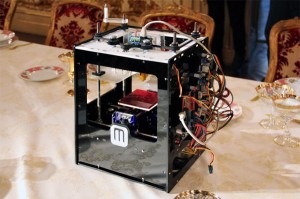PROTHESE
83-Jährige erhält Unterkiefer aus
dem 3D-Drucker
Belgische und niederländische Wissenschaftler haben zum ersten Mal einen kompletten Unterkiefer ersetzt. Die Prothese, die sie der 83-jährigen Patientin implantiert haben, wurde von einem 3D-Drucker aus Titanpulver aufgebaut.
Niederländische und belgische Ärzte haben einer 83-jährigen Frau eine Kieferprothese eingesetzt, die aus einem 3D-Drucker stammt. Es sei die erste Implantation dieser Art gewesen, teilten die Forscher mit. Die Operation fand bereits im Juni vergangenen Jahres statt, wurde aber erst jetzt öffentlich gemacht.
Die Patientin litt an einer chronischen Entzündung des Unterkiefers. Um die Atemwege offen zu halten sowie um lebenswichtige Funktionen wie Kauen und Schlucken zu erhalten, habe der Unterkiefer entfernt werden müssen.
Kürzere Operationsdauer
Eine herkömmliche Operation zur Wiederherstellung des Kiefers hätte eine längere Dauer und auch einen längeren Krankenhausaufenthalt bedeutet. Nicht zuletzt wegen des Alters der Patientin hätten sie sich deshalb zu dieser Operation entschlossen, erklärten die Ärzte.
Computergrafik des Implantats von vorne… (Bild: Layerwise)
An dem Projekt waren Forscher der Universitäten Hasselt und Leuven in Belgien sowie der Universitäten in Maastricht und Sittard-Geleen beteiligt, wo die Operation durchgeführt wurde. Den Unterkiefer hat das belgische Unternehmen Layerwise hergestellt. Er wurde aus Titanpulver gefertigt, das Schicht für Schicht mit einem Laser zu der Kieferprothese verschmolzen wurde. Anschließend wurde der Metallkiefer mit einer Biokeramik beschichtet.
33 Lagen pro Millimeter
Ein Millimeter der Prothese bestehe aus 33 Lagen, erklärte Ruben Wauthle, der bei Layerwise für medizinische Anwendungen zuständig ist, der BBC. Entsprechend waren mehrere tausend Lagen nötig, um das gesamte Werkstück aufzubauen.
In dem künstlichen Kiefer wurden Öffnungen ausgespart, die fördern sollen, dass sich die Muskeln mit dem Kiefer verbinden, und um das Wachstum der Nerven und Adern zu lenken. Zwar sei der Titankiefer mit 107 Gramm etwas schwerer als einer aus Knochen, doch damit werde sich die Patientin schnell zurechtfinden, glauben die Ärzte.
Sprechen und Schlucken
Das Einsetzen der Prothese dauerte nach Angaben der Ärzte nur vier Stunden. Eine Implantation mit herkömmlichen Methoden könne bis zu zwei Tage dauern. Die Patientin habe schon kurz nach dem Aufwachen die ersten Worte sagen können. Am Tag danach konnte sie bereits normal sprechen und schlucken.
Es sei das erste Mal gewesen, dass ein kompletter Unterkiefer ersetzt wurde, erklären die Wissenschaftler.
http://www.golem.de/news/prothese-83-jaehrige-erhaelt-unterkiefer-aus-dem-3d-drucker-1202-89589.html




